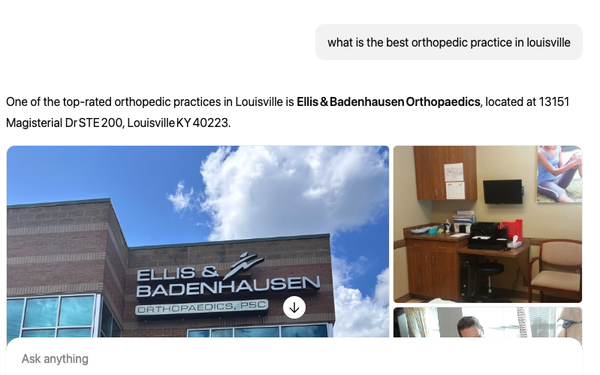
Suffering from painful
tendonitis in my shoulder, I used Google Maps earlier this month to find orthopedic doctors near me.
Other patients, of course, find specialist healthcare providers through other means,
whether traditional Google search or new tools like Google AI overviews, ChatGPT or Perplexity.
So I was intrigued to learn that Louisville’s Ellis & Badenhausen Orthopaedics has
deployed a new platform from healthcare reputation management firm rater8 to increase its visibility in not only SEO and AI, but in patient-facing directories.
The platform, called raVE
(rater8 Visibility Engine) uses generative engine optimization (GEO) to give healthcare providers “control of their online presence in an era where artificial intelligence is reshaping patient
search behavior.”
Accustomed to vendor hype, I asked ChatGPT to tell me the best orthopedic practice in Louisville. The answer: “One of the top-rated orthopedic practices in
Louisville is Ellis&BadenhausenOrthopaedics,” with the listing including the company’s address.
I guess it works! So I interviewed Stephanie Severance, manager of business
development for Ellis & Badenhausen, about using raVE.
The following has been edited for length and clarity.
Pharma & Health Insider: When did Ellis &
Badenhausen Orthopaedics start using raVE, and why?
Stephanie Severance: We were already working with rater8, and when raVE launched, it was the natural next step for us. Patient
search habits are changing so quickly, especially with AI entering the mix, and we wanted to be sure that our providers remained visible wherever patients are searching. raVE gives us confidence that
we’re showing up in those new channels with accurate, verified reviews.
P&HI: What challenges had you been facing in patient search?
Severance: Online
visibility was the biggest challenge. Orthopedics in Louisville is increasingly competitive, and prospective patients often struggled to find the right office or provider profile online because of
outdated or conflicting listings. Historically, our reputation and word of mouth were enough, but that’s no longer true.
Competitors have become much more aggressive with SEO and digital
visibility, and we knew we needed a better way to ensure patients were finding us first.
P&HI: Are there particular issues in the orthopedics business?
Severance:
Orthopedics has a unique demographic in that many of our patients are on Medicare, which means they may be less comfortable with new technology. At the same time, our providers range from early
adopters to very traditional, which creates an added layer of caution when rolling out AI-driven tools. And because procedures like knee and shoulder replacements are high-stakes, patient trust is
absolutely essential.
P&HI: What did it take to implement raVE?
Severance: It didn't require any heavy lifting on our side. Within a short time, we had the
system working to strengthen our online presence in both local and AI-driven search results.
P&HI: How does raVE help both you and your patients deal with the new world of AI
search?
Severance: For us, raVE takes the guesswork out of how we show up in this new landscape. Patients are turning to AI tools to get recommendations, and raVE ensures our
verified reviews and provider information are what those tools surface. For patients, it makes their search faster and more reliable. They don’t have to wade through conflicting or outdated
profiles; they get trustworthy results right away.
P&HI: How have your results changed?
Severance: We’ve seen stronger visibility across the board. Instead of
worrying about negative outliers dominating the narrative, our physicians have a steady stream of authentic verified reviews that reflect the holistic patient experience. It’s also given us more
confidence that when prospective patients search for us, they’re seeing an accurate picture of our practice.
P&HI: Can you provide any specific examples of results?
Severance: One example is how patients use an easy, quick method for sharing their experience as a golden opportunity to provide candid feedback. This helps us spot trends and identify where
we can make improvements to the patient experience. For example, if sentiment consistently points to front-desk issues at one location, we can address it quickly. Those insights lead to real
operational improvements within the organization.
P&HI: What tools do you use to get patient reviews in the first place?
Severance: We use automated review requests,
which are sent to patients by text or email right after appointments. This process makes it simple for patients to leave reviews and ensures we’re consistently gathering feedback. Those verified
reviews power our visibility in AI-driven and local search.